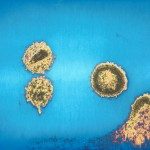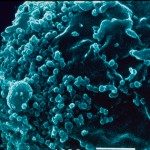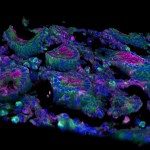Lien vers Pubmed [PMID] – 11929877
J. Biol. Chem. 2002 Jun;277(24):21776-85
The interfacial sequence DKWASLWNWFNITNWLWYIK, preceding the transmembrane anchor of gp41 glycoprotein subunit, has been shown to be essential for fusion activity and incorporation into virions. HIV(c), a peptide representing this region, formed lytic pores in liposomes composed of the main lipids occurring in the human immunodeficiency virus, type 1 (HIV-1), envelope, i.e. 1-palmitoyl-2-oleoylphosphatidylcholine (POPC):sphingomyelin (SPM):cholesterol (Chol) (1:1:1 mole ratio), at low (>1:10,000) peptide-to-lipid mole ratio, and promoted the mixing of vesicular lipids at >1:1000 peptide-to-lipid mole ratios. Inclusion of SPM or Chol in POPC membranes had different effects. Whereas SPM sustained pore formation, Chol promoted fusion activity. Even if partitioning into membranes was not affected in the absence of both SPM and Chol, HIV(c) had virtually no effect on POPC vesicles. Conditions described to disturb occurrence of lateral separation of phases in these systems reproduced the high peptide-dose requirements for leakage as found in pure POPC vesicles and inhibited fusion. Surface aggregation assays using rhodamine-labeled peptides demonstrated that SPM and Chol promoted HIV(c) self-aggregation in membranes. Employing head-group fluorescent phospholipid analogs in planar supported lipid layers, we were able to discern HIV(c) clusters associated to ordered domains. Our results support the notion that the pretransmembrane sequence may participate in the clustering of gp41 monomers within the HIV-1 envelope, and in bilayer architecture destabilization at the loci of fusion.



